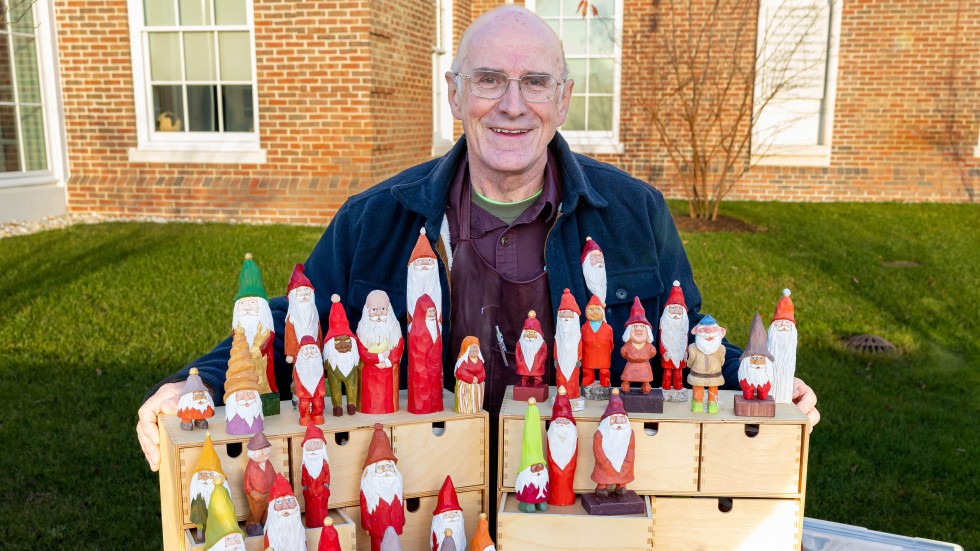
A Woodworker with a Calling
For Stonehill Professor Emeritus Warren Dahlin Jr., carving tomten is not unlike teaching.
“I started carving tomten over 25 years ago. I love the expressions each one takes on. I let the wood dictate what it wants to be—not unlike what we should do with students as professors,” says Dahlin, a longtime assistant professor of Healthcare Administration.
In the last quarter century, he’s carved well over a thousand tomten, he estimates. The little wooden figures may look like Santas or lawn gnomes, but the “benevolent elves” are part of Scandinavian folklore.
“All Scandinavian countries embrace the legends of the little people. One legend I read said they devolved from ancient trolls,” says Dahlin. “In earliest times, they lived around the family burial mounds of rural farms. In Sweden, they evolved to be small, most often, benevolent elves.”
According to legend, the little creatures will peek in windows and, Dahlin explains, “if they see their image on a window sill or high bureau, they'd be so delighted, they’d do good things around the farm for a whole year. I recall my mother saying we could leave the dishes and by the time we return, perhaps a tomte will have done them—he never did.”
When he spent Christmas 1968 with family in Sweden, Dahlin learned that often, instead of Santa and his reindeer, “toys are transported by sleigh pulled by a goat and directed by the tomten,” he says. “It's interesting because you think they use reindeer, but the goat is important” in Swedish culture.
“I started carving tomten over 25 years ago. I love the expressions each one takes on. I let the wood dictate what it wants to be—not unlike what we should do with students as professors,” says Dahlin.
The retired occupational therapist often carves outside on his Stoughton farm—but he'd like to one day carve on campus. “I love carving outdoors; I love to show people how it’s done. Perhaps I’ll do that next semester,” he says.
He also sells at area holiday craft fairs and donates a percentage of his profits to Stonehill’s H.O.P.E. program and the Barbara Lutted O’Donnell Scholarship Fund, which he established in 1990 to honor his high school teacher.
He had his last holiday fair on December 3, but you may see him walking around with a tomte pin. “During the season, I wear a jacket with a tomte pin on the lapel. If people admire the pin, I open my jacket to reveal scores of them—like genuine Rolex watches in Times Square,” he quips. (Though it does lead to sales.)
Growing up on his family’s Stoughton farm, Dahlin always worked with wood. In 1944, his Scandinavian grandfather’s friend came to live with his family. “He was like a grandfather to me. He was a woodworker and had a little woodshop on our land, so I have all his tools,” he says. “He used to work out there every day. From the time I was able to walk, he would babysit me. Woodwork has always been in my veins.”
Meanwhile, his Swedish aunt “used to put paintings up just before Christmas, all pictures of tomten. They’d be pulling sleds, feeding goats, looking in windows, skiing, falling down in the snow. When I asked her about it, she explained—that's where I first heard the legend. And there’s not enough magic in the world. So that really started my interest.”
For Dahlin, carving faces on the tomten is the most challenging part.
During the holiday season, Dahlin wears a tomte pin on his jacket. "If people admire the pin, I open my jacket to reveal scores of them..." says Dahlin.
When the war in Ukraine began, Dahlin began carving wooden Ukrainian eggs.
Of course, tomten aren’t all he makes. “As an OT [occupational therapist] with ADD [attention deficit disorder], I have countless hobbies,” Dahlin explains. He farms, paints, plays piano and accordion, blows glass, makes jewelry, works with copper, and, since the war in Ukraine, has started carving wooden Ukrainian eggs.
The tomten provide a challenge. He always "had a hard time carving faces. I think the human form is one of the hardest things. In fact, I took a sculpture course with Shane Savage-Rumbaugh [professor of studio arts].”
How many tomten does Dahlin carve per year?
“Good question. I don't count them. I don't know,” he says. “One week I might do 20 or 30. Another week, I'll do none. I’ve never really asked myself.”
He has a box of 120 right now. “They’re all so different when you have them all together. They look kind of alike, but each one has its own expression and personality.”
In general, he feels “a calling” to carve the figures, he says. It’s a connection to his ancestors. “For me, the tomten is just one of several hobbies I have that’ve kept me in touch with my ancestors. It’s meditation. I'll sit and listen to classical music and before I know it, I've carved four or five tomten. I also make wooden spoons and other stuff, so my life isn't totally directed by tomten,” he notes with a laugh. “But it is one of several ways that I can connect with the past and my Scandinavian culture.”
For years, of course, he was also passionate about teaching at Stonehill.
"I love Stonehill," Dahlin says, adding that his wife, Michele (Del Colliano) ’66, and his daughters, Ingrid ’97 and Emilia ’00, are alumnae. "I love watching people realize their unsuspected or unrealized potential. So many young people—and many older people as well—merely need permission and encouragement to be who or what they really want to be."
“For me, the tomten is just one of several hobbies I have that’ve kept me in touch with my ancestors. It’s meditation. I'll sit and listen to classical music and before I know it, I've carved four or five tomten..." says Dahlin.
